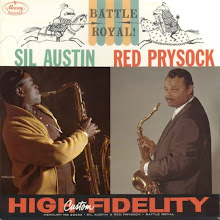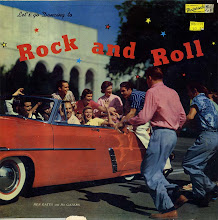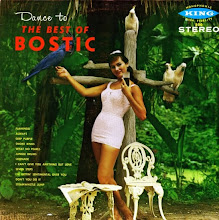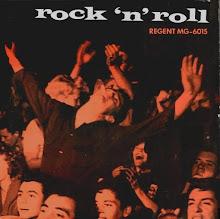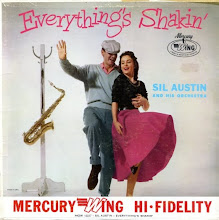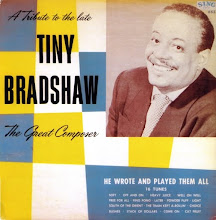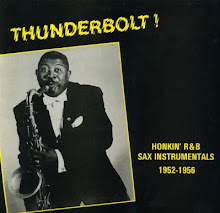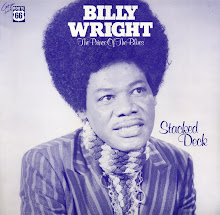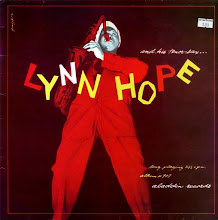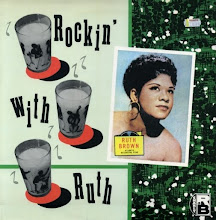

Side A
1. Creamin' Boogie - Julian Dash
2. For Squares Only - Julian Dash
3. Devil's Lament - Julian Dash
4. Dance of the Mother Bird - Julian Dash
5. Long Long Ago - Al Sears
6. Searsy - Al Sears
7. Tweedle Dee - Al Sears
8. So Glad - Al Sears
Side B
1. Walkin' Home - Eddie Chamblee
2. Goin' Long - Eddie Chamblee
3. Back Up - Eddie Chamblee
4. Lazy Mood - Eddie Chamblee
5. Time Out For The Blues - Ben Webster
6. Cotton Tail - Ben Webster
7. Surf Board - Ben Webster
8. You Are Too Beautiful - Ben Webster
Thanks to Big Al (The Bloggers’ Pal) here’s a real gone treat for the folks who move their feet to the saxlicious sound of the big beat.
This is one tremendous LP of sides recorded mostly by jazz / swing veterans but aimed mostly at the R&B market. There aren’t any squealing histrionics in the Big Jay McNeely or Joe Houston style, but what we have here is the very stuff of the Be Bop Wino blog – that grey area where jazz, swing, R&B and even rock ‘n’ roll all meet together. The very first track “Creamin’ Boogie” absolutely nails it for me with the deep down and dirty tone of Julian Dash set against a chugging boogie woogie piano. Life doesn’t get any better than this.
Julian Dash was a veteran of the Erskine Hawkins Orchestra, all the way back to when the band was known as the ‘Bama State Collegians in the late 1930s. He is credited with co-composing the Hawkins signature tune (and smash hit for Glenn Miller) “Tuxedo Junction.” Dash remained in the Hawkins outfit until the mid 1950s, but coinciding with the band’s longstanding Victor contract coming to an end, he recorded under his own name with small groups for labels like Sittin’ In With, Mercury and Vee-Jay from 1950 – 1955.
The personnel of these groups was made up of fellow members of the Hawkins Orchestra (which was also doing some label hopping at the time), such as Haywood Henry, Bobby Smith, Lee Stanfield, Leroy Kirkland and Sonny Payne. A similar line up was simultaneously recording for Apollo under Bobby Smith’s name.

“For Squares Only” and “Creamin’ Boogie” were recorded in New York City in March 1951 and released on Sittin’ In With 614.
“Devil’s Lament” and “Dance of the Mother Bird” were recorded in New York City in July 1951 and released on Sittin’ In With 630.
Al Sears, or rather “Big” Al Sears, was a tenor sax player of remarkable longevity whose career spanned the early years of big band swing (he joined the Chick Webb band in 1928), the glory years of swing in the 1930s and 1940s, the rise of small group R&B, and even rock and roll. Among the bands he played for in the 1940s into the early 1950s were those of Andy Kirk, Lionel Hampton and Duke Ellington (replacing Ben Webster.) In 1951 he was a member of the Johnny Hodges band and composed and soloed on their big hit on Mercury “Castle Rock.”
During the 1950s he recorded numerous tenor sax instros in New York for a succession of labels including King, Vic, Coral, Groove, Herald, Jubilee and Baton. He became a member of Alan Freed’s Rock and Roll Orchestra, playing numerous concerts and recording for Coral. Perhaps Big Al’s best recording for Freed was the aggressive stomper “Right Now, Right Now” which was featured in the film “Rock, Rock, Rock.”

“Long, Long Ago” and “Searsy” were recorded in New York City in 1945 and were first released as International 351/352.
“Tweedle Dee” was recorded in New York City in 1954 and first released on Herald 448.
“So Glad” was recorded in New York City in 1957 and first released on Jubilee 5303.
Eddie Chamblee belonged to a younger generation of sax players than the other three on this compilation and consequently received his grounding in the developing R&B scene of the mid to late 1940s rather than the swing era of the 1930s. Although born in Atlanta, his family relocated to Chicago where he eventually studied law at the University of Chicago. After playing for army bands during the war, he formed his own small group and signed up with Chicago indie label Miracle.
In 1948 Eddie was on one of the biggest selling R&B records of all time, playing tenor sax on Sonny Thompson’s two part instrumental “Long Gone.” The record (Miracle 126) was the 3rd biggest R&B seller of the year and shifted enough units to make Miracle the 4th biggest selling R&B label that year. None of the tracks Eddie recorded under his own name were to achieve anything like the success of “Long Gone” and his last session for Miracle was in 1949 including “Lazy Mood” which is featured here. Eddie recorded tracks for Coral in 1952 and United in 1953 – 54 before joining the Lionel Hampton band, staying until 1956. See the post “Live In Paris” to hear Eddie on a Hampton European tour.
In 1957 he married Ruth Jones, whom he had known when they both attended the same high school, and who was now enjoying enormous success as Dinah Washington. He recorded for the same label as Dinah – Mercury – with “Goin’ Long” and “Back Up” featuring here. And yes, he was still trying to revive that “Long Gone” groove on “Goin’ Long.” The post “The Rockin’ and Walkin’ Rhythm of Eddie Chamblee” is a good overview of his career.

“Lazy Mood” was recorded in Chicago in 1949 and first released on Miracle 133 and later released on Federal 12014.
“Walkin’ Home” was recorded in Chicago 1953 and released on United 160.
“Goin’ Long” and “Back Up” were recorded in Chicago in 1957 and released on Mercury 71107.
Ben Webster was a true giant of jazz tenor saxophone. Born in Kansas City in 1909, in the 1930s he worked with, among others, Benny Moten, Andy Kirk, Cab Calloway and Duke Ellington. However it is his work with Ellington in the early 1940s that is considered his most important. After leaving Ellington he worked mostly with his own small groups and also as a backing musician. R&B fans of course know that he was with Johnny Otis on Mercury in the early 1950s and he also recorded with Dinah Washington on the same label. In 1964 he moved to Europe where he was in great demand both as a live act and as a recording artist. The sides featured on this LP were recorded by Ben with Benny Carter and His All Stars for Modern.

“Cotton Tail” and “Time Out For The Blues” were recorded by Benny Carter and His All Stars in Los Angeles in May 1949 and first released on Modern 858 with dubbed on applause. “Time Out For The Blues” was retitled “Ben’s Mood” for the LP “Jazz Masquerade” (Modern 1209, Crown 5009) in 1956. It is likely that tracks credited to the “Jimmy Jackson All Stars” on singles released by RPM in 1952 are from this session.
“Surf Board” and “You Are Too Beautiful” were recorded by Benny Carter and His All Stars in Los Angeles in May 1949 and released on Modern 865.
Thank you Big Al!
1. Creamin' Boogie - Julian Dash
2. For Squares Only - Julian Dash
3. Devil's Lament - Julian Dash
4. Dance of the Mother Bird - Julian Dash
5. Long Long Ago - Al Sears
6. Searsy - Al Sears
7. Tweedle Dee - Al Sears
8. So Glad - Al Sears
Side B
1. Walkin' Home - Eddie Chamblee
2. Goin' Long - Eddie Chamblee
3. Back Up - Eddie Chamblee
4. Lazy Mood - Eddie Chamblee
5. Time Out For The Blues - Ben Webster
6. Cotton Tail - Ben Webster
7. Surf Board - Ben Webster
8. You Are Too Beautiful - Ben Webster
Thanks to Big Al (The Bloggers’ Pal) here’s a real gone treat for the folks who move their feet to the saxlicious sound of the big beat.
This is one tremendous LP of sides recorded mostly by jazz / swing veterans but aimed mostly at the R&B market. There aren’t any squealing histrionics in the Big Jay McNeely or Joe Houston style, but what we have here is the very stuff of the Be Bop Wino blog – that grey area where jazz, swing, R&B and even rock ‘n’ roll all meet together. The very first track “Creamin’ Boogie” absolutely nails it for me with the deep down and dirty tone of Julian Dash set against a chugging boogie woogie piano. Life doesn’t get any better than this.
Julian Dash was a veteran of the Erskine Hawkins Orchestra, all the way back to when the band was known as the ‘Bama State Collegians in the late 1930s. He is credited with co-composing the Hawkins signature tune (and smash hit for Glenn Miller) “Tuxedo Junction.” Dash remained in the Hawkins outfit until the mid 1950s, but coinciding with the band’s longstanding Victor contract coming to an end, he recorded under his own name with small groups for labels like Sittin’ In With, Mercury and Vee-Jay from 1950 – 1955.
The personnel of these groups was made up of fellow members of the Hawkins Orchestra (which was also doing some label hopping at the time), such as Haywood Henry, Bobby Smith, Lee Stanfield, Leroy Kirkland and Sonny Payne. A similar line up was simultaneously recording for Apollo under Bobby Smith’s name.

“For Squares Only” and “Creamin’ Boogie” were recorded in New York City in March 1951 and released on Sittin’ In With 614.
“Devil’s Lament” and “Dance of the Mother Bird” were recorded in New York City in July 1951 and released on Sittin’ In With 630.
Al Sears, or rather “Big” Al Sears, was a tenor sax player of remarkable longevity whose career spanned the early years of big band swing (he joined the Chick Webb band in 1928), the glory years of swing in the 1930s and 1940s, the rise of small group R&B, and even rock and roll. Among the bands he played for in the 1940s into the early 1950s were those of Andy Kirk, Lionel Hampton and Duke Ellington (replacing Ben Webster.) In 1951 he was a member of the Johnny Hodges band and composed and soloed on their big hit on Mercury “Castle Rock.”
During the 1950s he recorded numerous tenor sax instros in New York for a succession of labels including King, Vic, Coral, Groove, Herald, Jubilee and Baton. He became a member of Alan Freed’s Rock and Roll Orchestra, playing numerous concerts and recording for Coral. Perhaps Big Al’s best recording for Freed was the aggressive stomper “Right Now, Right Now” which was featured in the film “Rock, Rock, Rock.”

“Long, Long Ago” and “Searsy” were recorded in New York City in 1945 and were first released as International 351/352.
“Tweedle Dee” was recorded in New York City in 1954 and first released on Herald 448.
“So Glad” was recorded in New York City in 1957 and first released on Jubilee 5303.
Eddie Chamblee belonged to a younger generation of sax players than the other three on this compilation and consequently received his grounding in the developing R&B scene of the mid to late 1940s rather than the swing era of the 1930s. Although born in Atlanta, his family relocated to Chicago where he eventually studied law at the University of Chicago. After playing for army bands during the war, he formed his own small group and signed up with Chicago indie label Miracle.
In 1948 Eddie was on one of the biggest selling R&B records of all time, playing tenor sax on Sonny Thompson’s two part instrumental “Long Gone.” The record (Miracle 126) was the 3rd biggest R&B seller of the year and shifted enough units to make Miracle the 4th biggest selling R&B label that year. None of the tracks Eddie recorded under his own name were to achieve anything like the success of “Long Gone” and his last session for Miracle was in 1949 including “Lazy Mood” which is featured here. Eddie recorded tracks for Coral in 1952 and United in 1953 – 54 before joining the Lionel Hampton band, staying until 1956. See the post “Live In Paris” to hear Eddie on a Hampton European tour.
In 1957 he married Ruth Jones, whom he had known when they both attended the same high school, and who was now enjoying enormous success as Dinah Washington. He recorded for the same label as Dinah – Mercury – with “Goin’ Long” and “Back Up” featuring here. And yes, he was still trying to revive that “Long Gone” groove on “Goin’ Long.” The post “The Rockin’ and Walkin’ Rhythm of Eddie Chamblee” is a good overview of his career.

“Lazy Mood” was recorded in Chicago in 1949 and first released on Miracle 133 and later released on Federal 12014.
“Walkin’ Home” was recorded in Chicago 1953 and released on United 160.
“Goin’ Long” and “Back Up” were recorded in Chicago in 1957 and released on Mercury 71107.
Ben Webster was a true giant of jazz tenor saxophone. Born in Kansas City in 1909, in the 1930s he worked with, among others, Benny Moten, Andy Kirk, Cab Calloway and Duke Ellington. However it is his work with Ellington in the early 1940s that is considered his most important. After leaving Ellington he worked mostly with his own small groups and also as a backing musician. R&B fans of course know that he was with Johnny Otis on Mercury in the early 1950s and he also recorded with Dinah Washington on the same label. In 1964 he moved to Europe where he was in great demand both as a live act and as a recording artist. The sides featured on this LP were recorded by Ben with Benny Carter and His All Stars for Modern.

“Cotton Tail” and “Time Out For The Blues” were recorded by Benny Carter and His All Stars in Los Angeles in May 1949 and first released on Modern 858 with dubbed on applause. “Time Out For The Blues” was retitled “Ben’s Mood” for the LP “Jazz Masquerade” (Modern 1209, Crown 5009) in 1956. It is likely that tracks credited to the “Jimmy Jackson All Stars” on singles released by RPM in 1952 are from this session.
“Surf Board” and “You Are Too Beautiful” were recorded by Benny Carter and His All Stars in Los Angeles in May 1949 and released on Modern 865.
Thank you Big Al!




 In October 1956 the album presented in this post was issued as a 12 inch LP with 13 tracks (Aladdin LP-801). Volume 2 (Aladdin LP-802) which also had 13 tracks was released at the same time. See below for cover scans:
In October 1956 the album presented in this post was issued as a 12 inch LP with 13 tracks (Aladdin LP-801). Volume 2 (Aladdin LP-802) which also had 13 tracks was released at the same time. See below for cover scans:
 Tracks from the above two LPs were also issued on 3 EPs – Aladdin EPs 502, 503 and 513. See below for Joan’s EP 503 scan:
Tracks from the above two LPs were also issued on 3 EPs – Aladdin EPs 502, 503 and 513. See below for Joan’s EP 503 scan: In 1957 the two LPs were reissued with different titles and covers on Aladdin’s jazz/pop subsidiary Intro. Volume 1 became “Swinging Lester Young” (LP-602) and Volume 2 became “The Great Lester Young” (LP-603). In 1958 they were reissued on the Aladdin budget subsidiary Score (as SLP-4028 and SLP-4029) with the same covers and titles as the Intro issues. See below for Score cover scans:
In 1957 the two LPs were reissued with different titles and covers on Aladdin’s jazz/pop subsidiary Intro. Volume 1 became “Swinging Lester Young” (LP-602) and Volume 2 became “The Great Lester Young” (LP-603). In 1958 they were reissued on the Aladdin budget subsidiary Score (as SLP-4028 and SLP-4029) with the same covers and titles as the Intro issues. See below for Score cover scans:
 Subsequent releases of Lester Young Aladdin material on Imperial in the early 1960s were on two LPs (as two volumes of “The Great Lester Young”) with different tracks and covers.
Subsequent releases of Lester Young Aladdin material on Imperial in the early 1960s were on two LPs (as two volumes of “The Great Lester Young”) with different tracks and covers.
 Blue Note CDP 7243 8 32787 2 5:
Blue Note CDP 7243 8 32787 2 5:




 Now that I’ve reacquainted myself with the album as I plough my way through the conversion of the Boogie Woody vinyl vault to a digital format, I find myself appreciating the sheer genius of the music contained in the unjustly neglected grooves. The Ray-O-Vacs’ sound is rooted in that of the jive groups of the late 1930s and the 1940s and is similar to that of other self contained vocal / instrumental outfits like The Red Caps or The Four Blazes.
Now that I’ve reacquainted myself with the album as I plough my way through the conversion of the Boogie Woody vinyl vault to a digital format, I find myself appreciating the sheer genius of the music contained in the unjustly neglected grooves. The Ray-O-Vacs’ sound is rooted in that of the jive groups of the late 1930s and the 1940s and is similar to that of other self contained vocal / instrumental outfits like The Red Caps or The Four Blazes. Of the Decca releases, only “Besame Mucho” (covered some years later by The Coasters and then by The Beatles) achieved noteworthy sales. The Ray-O-Vacs’ sound was rapidly becoming old fashioned as rockin' gospel-influenced vocal groups began to dominate the R&B market. The Dominoes and The “5” Royales especially were a world away from the comparatively staid Ray-O-Vacs who seemed to belong more to the world of The Charioteers or The Delta Rhythm Boys.
Of the Decca releases, only “Besame Mucho” (covered some years later by The Coasters and then by The Beatles) achieved noteworthy sales. The Ray-O-Vacs’ sound was rapidly becoming old fashioned as rockin' gospel-influenced vocal groups began to dominate the R&B market. The Dominoes and The “5” Royales especially were a world away from the comparatively staid Ray-O-Vacs who seemed to belong more to the world of The Charioteers or The Delta Rhythm Boys.
 Now I have to confess that I have no idea when Flap joined the Ray-O-Vacs or how long he stayed with them. Perhaps someone out there can fill in the blanks?
Now I have to confess that I have no idea when Flap joined the Ray-O-Vacs or how long he stayed with them. Perhaps someone out there can fill in the blanks?
 Joan K has supplied a couple of label scans from Kaiser plus an issue on Sharp of “I’ll Always Be In Love With You”, which was the first Ray-O-Vacs’ recording to be issued, originally as a 78 rpm disc on Coleman in 1949. And as a final little treat from Joan there’s two m4a rips (plus mp3 conversions) from 78 rpm discs of “What’s Mine Is Mine” / “I Still Love You Baby”, originally released on Decca in 1950.
Joan K has supplied a couple of label scans from Kaiser plus an issue on Sharp of “I’ll Always Be In Love With You”, which was the first Ray-O-Vacs’ recording to be issued, originally as a 78 rpm disc on Coleman in 1949. And as a final little treat from Joan there’s two m4a rips (plus mp3 conversions) from 78 rpm discs of “What’s Mine Is Mine” / “I Still Love You Baby”, originally released on Decca in 1950.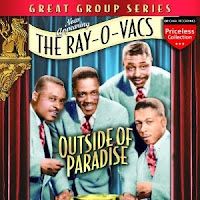 In the US two 22 track CDs were released on the Coleman label – “Besame Mucho” (Coleman 100) and “It’s Party Time with the Ray-O-Vacs” (Coleman 105). They’re probably just about impossible to find now.
In the US two 22 track CDs were released on the Coleman label – “Besame Mucho” (Coleman 100) and “It’s Party Time with the Ray-O-Vacs” (Coleman 105). They’re probably just about impossible to find now.
 A jive group who managed to get a hit in 1952 were The Four Blazes, with “Mary Jo” on the United label. Their sound was similar to that of The Ray-O-Vacs, with tasteful sax fills supplied by Eddie Chamblee. A 24 track Delmark CD, “Mary Jo” (DE-704) is highly recommended by your boogster pal. Oh, and by the way, I haven’t a clue who is playing sax on The Ray-O-Vacs’ sides. Can anyone help?
A jive group who managed to get a hit in 1952 were The Four Blazes, with “Mary Jo” on the United label. Their sound was similar to that of The Ray-O-Vacs, with tasteful sax fills supplied by Eddie Chamblee. A 24 track Delmark CD, “Mary Jo” (DE-704) is highly recommended by your boogster pal. Oh, and by the way, I haven’t a clue who is playing sax on The Ray-O-Vacs’ sides. Can anyone help?







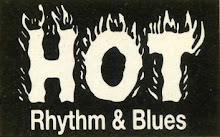
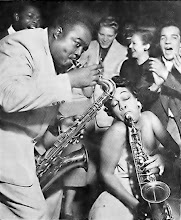






%2045%20-%201003A.png)
.jpg)
















